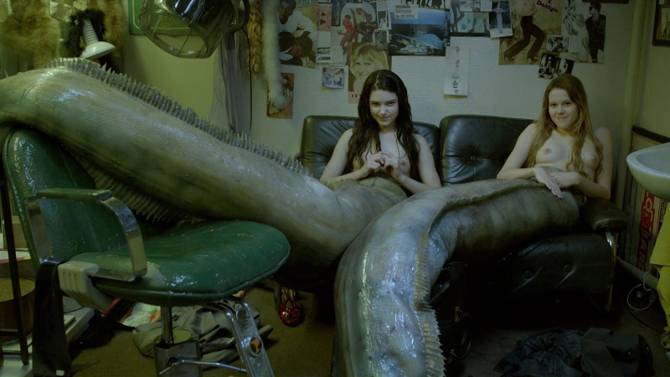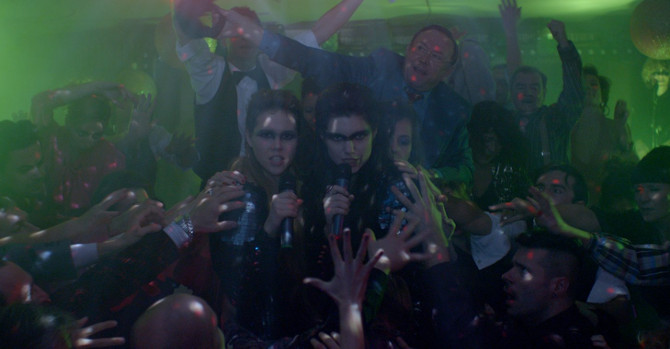If you’ve ever hoped someone would combine Hans Christian Andersen’s “The Little Mermaid” with touches of David Cronenberg’s psychological sexual thriller Crash (or many of the director’s other iconic horror features) and the quirky colours and music of Willy Wonka & the Chocolate Factory – then you’ve got one interesting imagination. . . and your time is here, as the 2015 Polish horror musical The Lure, directed by Agnieszka Smoczynska, walks this bizarre line.
Mesmeric in its colours and direction, some may wonder why make the film a musical. . . though, if you think about it, it makes perfect sense, as these half human/half monster hybrids are like the sirens of Homer’s epic poems, creatures that sing to allure and attract (it gets more gruesome after that) – it is in their essence. Set in Poland in the Communist era 1980s, the story follows mermaid sisters Silver (Marta Mazurek) and Golden (Michalina Olszańska) – they have a yin and yang quality, the former a more compassionate being learning to love, the latter a more violent, dangerous beast – as they make their way into a foreign landscape.
Luring their way into the lives of a band (aptly named Figs n’ Dates) they meet on the beach – lead singer Krysia (Kinga Preis) and the drummer (Andrzej Konopka) are a couple, while the much younger bassist Mietek (Jakub Gierszal) lives with them, it is a moment that will change all of their lives.
Taking them into their unorthodox world, the mermaids, who have an unattractive, almost sea monster-like tail, have legs the likes of Barbie when dry. . . smooth, hairless, with no private parts. The opening introduction to the nightclub where the band works is brilliantly shot – a kaleidoscopic high end erotic music hall where couples have dinner while enjoying the shows; there is a kinetic, abstract energy in the place. The atmosphere is awkwardly electric – a comedic tinge that is somewhat reminiscent of the shindig Jim Carrey’s character throws in The Cable Guy. The elderly manager (Zygmunt Malanowicz) soon hires the hypnotic pair as background singers/strippers for the band’s frequent performances. . . though soon, they form their own super duo known as “The Lure”.
Though on the surface a seemingly straight-forward (though unusual) tale, below the rippling water this is a coming of age saga, Silver and Golden symbolic of the transformation from girls into young women. Not only do their tails smell like fish (it is also where their genitals are), but they experience something new at every turn (intense popularity – sometimes chauvinistic attention, cigarettes, alcohol, first love, harsh violence and betrayal) – learning how to live, with newfound challenges, as they change drastically in a short amount of time. It is not always easy, as Golden falls for Mietek (and though he loves her as well, he is rather bothered by her being a fish – the lack of a port of entry, so to speak, is likely the major reason), this causes her to struggle with her self image as a mermaid, while Silver’s hormones bring forth unexpected spurts of arousal and violent anger. Yet, there are also distinct changes from the average tumultuous teenage years, as the pair’s undersea childhood does not bring with it feelings of shame and fear when it comes to being naked (they prance around, unaware that this is far from the norm), while there is also that other little thing. . . their love of the ‘other, other white meat’.
A number of mythical elements pop up as the story moves along; Golden meets a heavy metal singer named Tryton (Marcin Kowalczyk), a formerly horned sea creature also living in the open air. . . he warns her of the mermaid’s curse: that is, if someone you love marries another person, you will turn to foam – the only way to stop it, eat him before that morning’s sunrise. Another mermish myth heard muttered is that if you remove your tail, you lose your ability to sing and speak.
Screenwriter Roberto Bolesto based the mermaid characters on his two friends, Barbara and Zuzanna Wrońska (of the Polish Indie Band Ballady i Romanse – the pair write quite a bit of the music in the movie), though intriguingly, it also echoes director Smoczynska’s own upbringing, as her mother managed a nightclub much like the one seen in the film – the mermaids going through many of the firsts she did. This is likely why it feels so real – the way the kitchen runs, the lighting schemes (brought to life by cinematographer Jakub Kijowski), the palpable energy, the excitable crowd, the sex in the back rooms, the after hours drinking – it adding an absurdist authenticity to the piece.
An audacious effort from a first time filmmaker, The Lure is a strikingly original motion picture. Though it is not without its flaws (some more depth to further enrich the lore found in the story, a little more clarity in the narrative), it transcends its problems, always quite fascinating and can never be called boring. With a wonderful visual cadence, Smoczynska swings back and forth between styles: the dialogue sequences simplistic – often handheld, short on edits and flair; while the musical numbers are utterly grand – full of style and panache. A final note must be made about the fascinating tails. Designed with real materials rather than using computer generated effects, the more than six foot long, fifty plus pound costumes make things more believable – the actors learn to move more fluidly with the added appendage, those not playing the mermaids able to interact with them as well (there is also a greater authenticity to the visual cinematography when something is actually being filmed on camera). So, take a bite out of this unique Polish dish, it is well worth grabbing your big foam finger to cheer it on.
This film is in Polish with English subtitles


